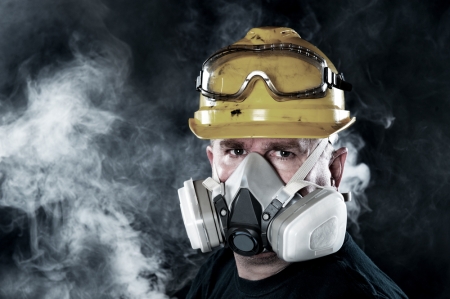Among the products that are overlooked when buying supplies for your facility, entrance mats are probably one of the most neglected. Far too many people consider entrance mats as decoration. Some think as long as it bears the customary welcome message, any generic variant is considered an adequate solution. This means that many people are failing to use these mats to their full advantage.
Archive for the ‘work-zone-safety’ Category
Top Four Reasons Why You Should Install Bollards

Bollards are often used in parks, worksites, along sidewalks, in front of establishments, and throughout parking lots. They provide an effective barrier to block both foot and vehicle traffic in outdoor environments. If you aren’t using steel bollards yet, it may be time to consider adding them to your workplace safety plan.
Here are the benefits of installing bollards in your outdoor spaces:
(more…)Improving Pedestrian Safety in a Forklift Environment


Can traffic accidents happen only in parking lots or on busy streets?
Unfortunately, no. According to the National Institute for Occupational Safety and Health (NIOSH), 20,000 workers are seriously injured each year in the United States due to forklift-related incidents. 100 employee fatalities are also reported due to the same reason. Many workers and employers are unaware of forklift hazards and are not following the procedures set forth in federal regulations or equipment manufacturer guidelines.
Pedestrian safety can be improved with appropriate preventative measures in environments with frequent forklift traffic. Detailed awareness training, effective traffic management, and the use of proper safety equipment make this possible. Both drivers and pedestrians can make a difference in reducing forklift-related accidents.
Employee Training
Employees who work around forklifts (whether directly or not) are responsible for safe forklift operations. The following pointers can help ensure that forklift operations remain safe for pedestrians and operators alike:
- Only qualified drivers should operate forklifts, and forklift operators should always be aware of pedestrians in the area.
- Operators should stay in marked routes, slow down, and sound their horns when approaching intersections, corners, or turns.
- Pedestrians should be aware of forklifts in the area and maintain a safe distance. Pedestrians should pause to look both ways before stepping through a side door, around a corner, or into an aisle.
- Employees approaching forklifts should make sure that the driver is aware of their presence. Pedestrians should always approach them from the side, never directly in front or behind, and only when the vehicle comes to a full stop.
- Employees should never try to overtake a forklift. Let the forklift pass instead.
- Employees should avoid standing in areas where they may be pinned against a wall or fixture.
- Employees should not walk or work beneath truck loads.
- Most forklifts accommodate one driver only. Employees may only ride when a proper seat is provided.
- Trucks should not exceed their load capacity.
- Immediately report malfunctions and other problems to the proper personnel.
- Aisles and adjacent areas should be clear of obstructions. Clean up spills promptly.
Traffic Management Measures
Warehouses, industrial plants, and other large facilities should implement protocols regarding the right of way. Vehicle and pedestrian routes should remain separate as much as possible, identified by the proper signage and pavement lines. Operators and pedestrians should be familiar with both routes, not just the ones they are most likely to use. When applicable, facilities should also have traffic barriers set up.
Safety Equipment
Forklifts must have horns and warning lights. Alarms are also extra safety precautions to add to any machinery in your warehouse. Curved mirrors can improve pedestrian visibility, especially at intersections. Pedestrians should always wear high-visibility vests when walking or working near high-traffic areas.
Pedestrian forklift safety is an important part of your warehouse safety program. Promote forklift safety awareness to constantly remind your employees to pay attention and be aware of their surroundings. Emedco offers innovative warehouse safety products to help reduce accidents involving industrial equipment and improve your facility’s safety tactics.
Work zone Awareness within the Work zone
A lot of emphasis is put on the driver passing through a work zone area when it comes to protecting road workers; however there are a lot of hazards happening within the work zone as well that should never be ignored. Within a work zone, how workers’ communicate and maneuver around large machinery; with many distractions and ever changing environmental factors, can be a challenging feat to accomplish without injury.
When operating large machinery it is difficult to maneuver tactfully through a congested work zone; hearing can be difficult and blind spots are inevitable. A few key tips for all operators to keep in mind include:
- Inspect every piece of machinery before it is used. If you notice any defects, remove it from your work site, alert a manager and do not use it until repairs have been made
- Try to do everything within your power to reduce blind spots by cleaning down mirrors and windows and making sure they are properly adjusted for most effective use
- Maintain 100% comprehension with your spotter at all times, stop immediately if you are ever unable to understand their signals or lose sight of them
When working in a zone with large machinery, a worker is defenseless should an accident occur. PPE is no match for the tons of force in motion. To protect workers these tips are important:
- Make yourself as visible as possible with high visibility gear, reflector and lights
- Be aware of equipment navigation routes and try to stay out of them
- Listen for reverse signals and use the proper communication signals and processes when interacting with a machine operator
- Do not ever approach a machine in operation unless you have been given clear confirmation that it is ok to do so
For more information on some of the regularly cited compliance regulations and guidelines when putting together an effective work zone safety plan for workers, traffic control, vehicles etc. see:
- 29 CFR 1926, Subparts O and G
- Manual on Uniform Traffic Control Devices [DOT 2009]
- ANSI/ASSE A10.47‒2009
- ANSI/ISEA 207‒2011
- ANSI/ISEA 107‒2010
Balancing Production and Protection: ROI of Workplace Safety
It is kind of crazy when you think about it, that facilities actually have to “justify” the importance of safety purchases that could save the lives of workers; as if a workers life doesn’t come with any value to begin with. So looking beyond the obvious ROI of saving a HUMAN LIFE, when trying to convince your managers that new safety changes are going to benefit the company, focus on these 3 areas.
Productivity
Do you work better when you are side tracked by the feeling that what you are doing might be harmful to your well being? Chances are the answer is no, and it is the same for your workforce. When processes have built in barriers to protect workers from hazards they are free to work carefree and uninhibited. When work becomes intuitive processes become smoother and more flexible if timelines change.
Morale
Employees are more likely to put more effort and pride into the work they are doing if they feel like they are part of a company that sees and acknowledges their value. Part of “acknowledging their value” definitely includes keeping them safe. Recognizing that your workers have lives and people that are important to them outside of work and providing them with the safety precautions they need to ensure that they will be able to return to them after hours is important in more ways than one.
Cost Savings
If you work in a safety position your have heard all of the same stats over and over again; “for every dollar spent on safety you save 2 in injury and production costs” “Injuries, Workers Comp, Insurance, Lost Time, Fines” so on and so forth. While the multipliers may differ from company to company the likelihood and the impact should an accident occur because the proper safety precautions were not in place are enough to severely hinder and operation if not shut a company down completely.
Stop Work Authority: Empower Your Workers to Make the Right Safety Call
Stop , collaborate and listen, stop work if you have an affliction. Isn’t that how the song goes? In any case, stop work authority is an important aspect in any workplace. While experience levels and knowledge of process vary greatly at any job, all workers should be trained on procedures to follow if they feel unsafe in a task that they have been asked to carry out.
So what is stop work authority exactly? Usually a program developed by individual companies, it is designed to give workers or contractors the responsibility to stop work if there is perceived danger in the work they are doing that they feel has not been properly addressed.
Common situations where stop work may be enacted include:
- If there is a sudden change in work conditions
- If a near miss accident happen in the course of work
- If a worker lacks the knowledge/information/understanding to carry out a task
- If there is an emergency
- If the proper equipment is not provided
- If there is clear and present danger or conditions
Stop work authority does not just fall to workers, a whole organization must be actively involved in the process to make sure workers feel that they will be properly supported if they to “stop work”. Upper management should demonstrate an accepting stop work culture and provide clear expectations for the policy. Supervisors should promote and reinforce stop work procedures and make sure the process is handled correctly and dangers are resolved and followed up with. Workers should understand the seriousness of what stop work means and initiate stop work and support others who do so when they is danger.
Do you feel like you have given your workforce the tools and support they need to stop work if necessary?
Get Familiar with Respirator Types
The first respirator has been traced back to the first century when Pliny the Elder (A.D. 23-79) described the use of animal bladder skins to protect roman miners from red lead oxide dust. Needless to say we’ve come a long way in terms of respirator technology but the goal remains the same: prevent harmful particles from being inhaled. Respirators today come in a variety of forms.

Nowadays, there are 4 popular kinds of respirators separated by how they work: mechanical filter respirators, chemical cartridge respirators, powered air-purifying respirators (PAPR) and self-contained breathing apparatuses(SCBA).
Get Ready: How to Prepare Your Workers for Emergencies
When a heat wave, earthquake or tornado strikes, do your employees know exactly what to do? The National Weather Service (NWS) recorded a total of 446 fatalities due to severe weather conditions in 2013. From this figure, males accounted for 307 deaths, which were more than double than the female deaths amounting to 125. NWS attributed this typical gender discrepancy of weather-related deaths to the fact that more men hold outdoor occupations such as construction and masonry or perform open-air activities such as fishing and boating.

REALITY CHECK. Are your workers ready for this?
September is National Preparedness Month, and now is the best time to arm your workers with tools and valuable knowledge they can utilize to combat unavoidable calamities. Here, we have outlined an emergency preparedness checklist you can follow to better keep your employees on their toes even before disaster happens.
A Higher Dimension: Why Use 3D Projection Signs
In cases of emergency, even a few seconds can be the difference between “saved” and “impaired”, which is why you need to install signs that immediately inform your workers what to do and where to proceed to when an accident occurs.

NEVER SKIP A HEARTBEAT. A 3D AED sign quickly informs your workers where they can find an automated external defibrillator.
Emedco is launching new 3D first aid signs, which are perfect for that job. Here’s why:
10 Ways to Beat the Stress of Working in the Summer Heat
Summer weather means temperatures are high, humidity is up, and any chance of a breeze is non-existent. But for a worker, it also means safety glasses fogging up, excessively sweaty hands from wearing gloves, pools of sweat inside the ears from plugs, difficulty in breathing because of respirators, and the list goes on. There is also the very real danger of heat stress. In these conditions, making sure your employees are wearing the required PPE can be quite a challenge. A risk assessment by a trained specialist is a wise investment to ensure both PPE requirements and your workers’ comfort are being met.
Here are ten other tips on how your outdoor workers can beat the summer heat: (more…)




